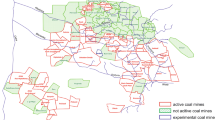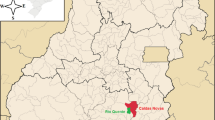Abstract
Water quality was evaluated in a coal mining area in the city of Figueira, Paraná State, Brazil, where uranium was associated with the coal deposit. Upstream the mine, groundwaters were more acid and some elements and compounds, such as iron, aluminum, and sulfate, were in higher concentration, possibly because of acid mine drainage (AMD) generation in tailing pit. 238U and 234U activity concentrations exceeded the standards proposed by the World Health Organization in two sampling periods in effluent samples and in some groundwater samples, indicating that waters from this aquifer system were unhealthy for human consumption. Uranium isotopes were more elevated in groundwaters in the rainy month probably because of a higher leaching and transport rate of this element from rocks/tailings pit to waters. The average radon activity concentration in groundwater was higher than in surface waters and effluents in both periods studied, possibly due to the enhanced presence of uranium and radium in the aquifer rocks that would favor the radon accumulation and entrapment. The effects of the mining activities on the groundwater quality were displayed in terms of activity ratios (234U/238U, 226Ra/238U), which showed different behaviors upstream the mine area relatively to areas downstream the mine.





Similar content being viewed by others
References
Akcil, A., & Koldas, S. (2006). Acid mine drainage (AMD): causes, treatment and case studies. Journal of Cleaner Production, 14, 1139–1145. doi:10.1016/j.jclepro.2004.09.006.
ANEEL (Agência Nacional de Energia Elétrica) (2011) A Situação da Produção de Carvão Mineral no Estado do Paraná em Relação a Nota Técnica 034/2011. Tech. Rep, ANEEL, Brasília.
Arbuzov, S. I., Maslov, S. G., Volostnov, A. V., & Arkhipov, V. S. (2012). Modes of occurrence of uranium and thorium in coals and peat of Northern Asia. Solid Fuel Chemistry, 46, 52–66. doi:10.3103/S0361521912010028.
Arnold, T., Baumann, N., Barsch, E. K., Brockmann, S., Zimmermann, U., & Weis, U. S. (2011). Identification of the uranium speciation in an underground acid mine drainage environment. Geochimica et Cosmochimica Acta, 75, 2200–2212. doi:10.1016/j.gca.2011.01.037.
Asikainen, M. (1981). State of disequilibrium between 238U, 234U, 226Ra and 222Rn in groundwater from bedrock. Geochimica et Cosmochimica Acta, 45, 201–206. doi:10.1016/0016-7037(81)90163-0.
Bachmaf, S., & Merkel, B. J. (2011). Sorption of uranium(VI) at the clay mineral–water interface. Environmental Earth Science, 63, 925–934. doi:10.1007/s12665-010-0761-6.
Baik, M. H., Hyun, S. P., & Hahn, P. S. (2003). Surface and bulk sorption of uranium (VI) onto granite rock. Journal of Radioanalytical and Nuclear Chemistry, 256, 11–18. doi:10.1023/A:1023331521718.
Balogun, F. A., Mokobia, C. E., Fasasi, M. K., & Ogundare, F. O. (2003). Natural radioactivity associated with bituminous coal mining in Nigeria. Nuclear Instruments and Methods in Physics Research, 505, 444–448. doi:10.1016/S0168-9002(03)01117-3.
Berghorn, G. H., & Hunzeker, G. R. (2001). Passive treatment alternatives for remediating abandoned mine drainage. Remediation Journal, 11(3), 111–127. doi:10.1002/rem.1007.
Bizzi, L. A., Schobbenhaus, C., Vidotti, R. M., & Gonçalves, J. H. (2003). Geologia, Tectônica e Recursos Minerais do Brasil: texto, mapas e SIG. Brasília: CPRM.
Bonotto DM. (1996). Comportamento hidrogeoquímico do 222Rn e isótopos de urânio 238U e 234U sob condições controladas de laboratório e em sistemas naturais. Post PhD Thesis, UNESP, Rio Claro.
Bonotto, D. M. (2006). Hydro(radio)chemical relationships in the giant Guarani aquifer, Brazil. Journal of Hydrology, 323, 353–386. doi:10.1016/j.jhydrol.2005.09.007.
Bonotto, D. M. (2011). Natural radionuclides in major aquifer systems of the Paraná sedimentary basin, Brazil. Applied Radiation and Isotopes, 69, 1572–1584. doi:10.1016/j.apradiso.2011.06.002.
Bonotto, D. M., & Andrews, J. N. (1993). The mechanism of 234U/238U activity ratio enhancement in karstic limestone groundwater. Chemical Geology, 103, 193–206. doi:10.1016/0009-2541(93)90301-X.
Boryło, A., & Skwarzec, B. (2014). Activity disequilibrium between 234U and 238U isotopes in natural environment. Journal of Radioanalytical and Nuclear Chemistry, 300, 719–727. doi:10.1007/s10967-014-3001-9.
Burnett, W. C., & Elzerman, A. W. (2001). Nuclide migration and the environmental radiochemistry of Florida phosphogypsum. Journal of Environmental Radioactivity, 54, 27–51. doi:10.1016/S0265-931X(00)00164-8.
Campaner, V. P., Luiz-Silva, W., & Machado, W. (2014). Geochemistry of acid mine drainage from a coal mining area and processes controlling metal attenuation in stream waters, southern Brazil. Anais da Academia Brasileira de Ciências, 86(2), 539–544. doi:10.1590/0001-37652014113712.
Cowart JB and Osmond JK (1974) 234U and 238U in the carrizo sandstone aquifer of South Texas. In: Isotope techniques in groundwater Hydrology vol. II. Pp. 131-149, IAEA.
Cowart, J. B., & Osmond, J. K. (1980). Uranium isotopes in groundwater as a prospecting technique. Colorado: Deptartment of Energy.
Currie, L. A. (1968). Limits for qualitative and quantitative determination. Analytical Chemistry, 40, 586–593. doi:10.1021/ac60259a007.
Depo, F. S., Pozebon, D., & Kalkreuth, W. D. (2008). Chemical characterization of feed coals and combustion-by-products from Brazilian power plants. International Journal of Coal Geology, 76, 227–236. doi:10.1016/j.coal.2008.07.013.
Doi, K., Hirono, S., & Sakamaki, Y. (1975). Uranium mineralization by groundwater in sedimentary rocks, Japan. Economic Geology, 70(4), 628–646. doi:10.2113/gsecongeo.70.4.628.
Emirhan, M. E., & Ozben, C. S. (2009). Assessment of radiological risk factors in the Zonguldak coal mines. Turkey. J. Radiol. Prot., 29, 527–534. doi:10.1088/0952-4746/29/4/007.
Equeenuddin, S. M., Tripathy, S., Sahoo, P. K., & Panigrahi, M. K. (2010). Hydrogeochemical characteristics of acid mine drainage and water pollution at Makum Coalfield, India. Journal of Geochemical Exploration, 105, 75–82. doi:10.1016/j.gexplo.2010.04.006.
Ferronsky, V. I., Polyakov, V. A., & Ferronsky, S. V. (1982). Environmental isotopes in the hydrosphere. New York: Wiley.
Flues, M., Camargo, I. M. C., Silva, P. S. C., & Mazzilli, B. P. (2006). Radioactivity of coal and ashes from Figueira coal power plant in Brazil. Journal of Radioanalytical and Nuclear Chemistry, 270(3), 597–602. doi:10.1007/s10967-006-0467-0.
Francis, A. J. (1990). Microbial dissolution and stabilization of toxic metals and radionuclides in mixed wastes. Experientia, 46, 840–851. doi:10.1007/BF01935535.
Galhardi, J. A., & Bonotto, D. M. (2016). Hydrogeochemical features of surface water and groundwater contaminated with acid mine drainage (AMD) in coal mining areas: a case study in southern Brazil. Environmental Science and Pollution Research, 23, 18911–18927. doi:10.1007/s11356-016-7077-3.
Genitron. (2000). Alpha Guard PQ2000/MC50—multiparameter radon monitor. Frankfurt: Genitron Instruments.
Giblin, A. M., Batts, B. D., & Swaine, D. J. (1981). Laboratory simulation studies of uranium mobility in natural waters. Geochimica et Cosmochimica Acta, 45, 699–709. doi:10.1016/0016-7037(81)90043-0.
Godoy, J., & Godoy, M. (2006). Natural radioactivity in Brazilian groundwater. Environmental Radioactivity, 85, 71–83. doi:10.1016/j.jenvrad.2005.05.009.
Grandstaff, D. E. A. (1976). Kinetic study of the dissolution of uraninite. Economic Geology, 71, 1493–1506. doi:10.2113/gsecongeo.71.8.1493.
Hakama, O. K., Choukri, A., Reyss, J. L., & Lferd, M. (2001). Determination and comparison of uranium and radium isotopes activities and activity ratios in samples from some natural water sources in Morocco. Journal of Environmental Radioactivity, 57, 175–189. doi:10.1016/S0265-931X(01)00016-9.
Hu, M. Z. C., Norman, J. M., Faison, N. B., & Reeves, M. (1996). Biosorption of uranium by Pseudomonas aeruginosa strain CSU: characterization and comparison studies. Biotechnology and Bioengineering, 51, 237–247. doi:10.1002/(SICI)1097-0290(19960720)51:2<237::AID-BIT14>3.0.CO;2-J.
Hussain, N., & Krishnaswami, S. (1980). U-238 series radioactive disequilibrium in groundwaters: Implications to the origin of excess U-238 and fate of reactive pollutants. Geochimica et Cosmochimica Acta, 44, 1287–1291. doi:10.1016/0016-7037(80)90089-7.
Ivanovich, M., & Harmon, R. S. (1992). Uranium-series disequilibrium: applications to earth, marine, and environmental sciences. Oxford: Clarendon Press.
Jia, M. B., Sansone, U., Rosamilia, S., & Gaudino, S. (2005). Concentration and characteristics of depleted uranium in water, air and biological samples collected in Serbia and Montenegro Guogang. Applied Radiation and Isotopes, 63, 381–399.
Krebs, A. S. J., & Alexandre, N. Z. (1998). Situação atual dos recursos hídricos da bacia carbonífera, face às atividades de lavra, beneficiamento e uso do carvão mineral e de outras atividades antrópicas (pp. 60–65). Bahia: Proceedings of IX Congresso Brasileiro de Águas Subterrâneas.
La, J. C. (1992). Natural radionuclides in groundwaters. Journal of Radioanalytical and Nuclear Chemistry, 156(2), 235–242. doi:10.1007/BF02038341.
Langmuir, D. (1978). Uranium solution-mineral equilibria at low temperatures with applications to sedimentary ore deposits. Geochimica et Cosmochimica Acta, 42, 547–569. doi:10.1016/0016-7037(78)90001-7.
Luo, S., The-Lung, K., Roback, R., Murrel, M., & McLing, T. (2000). In-situ radionuclide transport and preferential groundwater flows at INEEL (Idaho): decay-series disequilibrium studies. Geochimica et Cosmochimica Acta, 64(5), 867–881. doi:10.1016/S0016-7037(99)00373-7.
Mancini, L. H., & Bonotto, D. M. (2006). Migração de rádio nas águas superficiais e subterrâneas do Morro do Ferro e complexo alcalino do Barreiro, Minas Gerais, Brasil. Geochimica Brasiliensis, 20, 251–266.
Medeiros, R. A., & Thomaz Filho, A. (1973). Fácies e ambientes deposicionais da Formação Rio Bonito. XXVII Congresso Brasileiro de Geologia, São Paulo, 3, 3–12.
Mejean, P., Pinti, D. L., Larocque, M., Ghaleb, M., Meyzonnat, G., & Gagne, S. (2016). Processes controlling 234U and 238U isotope fractionation and helium in the groundwater of the St. Lawrence Lowlands, Quebec: the potential role of natural rock fracturing. Applied Geochemistry, 66, 198–209. doi:10.1016/j.apgeochem.2015.12.015.
Mkandawire, M. (2013). Biogeochemical behaviour and bioremediation of uranium in waters of abandoned mines. Environmental Science and Pollution Research, 20, 7740–7767. doi:10.1007/s11356-013-1486-3.
Moore, G. W. (1954). Extraction of uranium from aqueous solution by coal and some other material. Economic Geology, 49, 652–658. doi:10.2113/gsecongeo.49.6.652.
Morrone N and Daemon RF (1985) Jazida de Urânio de Figueira, Paraná, in: Principais Depósitos Minerais do Brasil: Recursos minerais energéticos. Departamento Nacional de Produção Mineral, Brasília, pp. 133–142.
Prikryl, J. D., Jain, A., Turner, D. R., & Pabalan, R. T. (2001). Uranium(VI) sorption behavior on silicate mineral mixtures. Journal of Contaminant Hydrology, 47, 241–253. doi:10.1016/S0169-7722(00)00153-4.
Saad S (1974) Aspectos da mineralização uranífera de Figueira (PR). Comissão Nacional de Energia Nuclear, Boletim No 8, Rio de Janeiro.
Shuqair, MSS (2002) Estudo da contaminação do solo e água subterrânea por elementos tóxicos originados dos rejeitos das minas de carvão de Figueira no Estado do Paraná. PhD Thesis, Universidade de São Paulo, São Paulo.
Silva, L. F. O., Vallejuelo, S. F. O., Martinez-Arkarazo, I., Castro, K., Oliveira, M. L. S., Sampaio, C. H., Brum, I. A. S., Leão, F. B., Taffarel, S. R., & Madariaga, J. M. (2013). Study of environmental pollution and mineralogical characterization of sediment rivers from Brazilian coal mining acid drainage. Science of the Total Environment, 447, 169–178. doi:10.1016/j.scitotenv.2012.12.013.
Simona, R., Andreas, B., & Stefan, P. (2004). Formation and stability of schwertmannite in acidic mining lakes. Geochimica et Cosmochimica Acta, 68, 1185–1197. doi:10.1016/j.gca.2003.07.015.
Skwarzec, B., Boryło, A., & Struminska, A. (2002). 234U and 238U isotopes in water and sediments of the southern Baltic. Journal of Environmental Radioactivity, 61, 345–363. doi:10.1016/S0265-931X(01)00144-8.
UNSCEAR (United Nations Scientific Committee on the Effects of Atomic Radiations) (2010) Sources and effects of ionizing radiations. New York: UNSCEAR, 2010 http://www.unscear.org.
Veiga, L. H. S., Melo, V., Koifman, S., & Amaral, E. C. S. (2004). High radon exposure in a Brazilian underground coal mine. Journal of Radiological Protection, 24, 295–305.
WHO (World Health Organization) (2011) Guidelines for drinking water quality, 4th ed. Geneve: WHO, 2011. http://www.who.int/water_sanitation_health/publications/2011/dwq_guidelines/en/.
Zielinski, R. A., & Meier, A. L. (1988). The association of uranium with organic matter in Holocene peat: an experimental leaching study. Applied Geochemistry, 3, 6314–6343. doi:10.1016/0883-2927(88)90095-9.
Zielinski, R. A., Al-Hwaiti, M. S., Budahn, J. R., & Ranville, J. F. (2011). Radionuclides, trace elements, and radium residence in phosphogypsum of Jordan. Environmental Geochemical Health, 33, 149–165. doi:10.1007/s10653-010-9328-4.
Acknowledgements
National Council for Scientific and Technological Development (CNPq) in Brazil is thanked for financial support of this investigation. We thank two anonymous referees for their helpful comments that improved the readability of the manuscript.
Author information
Authors and Affiliations
Corresponding author
Rights and permissions
About this article
Cite this article
Galhardi, J.A., Bonotto, D.M. Radionuclides (222Rn, 226Ra, 234U, and 238U) Release in Natural Waters Affected by Coal Mining Activities in Southern Brazil. Water Air Soil Pollut 228, 207 (2017). https://doi.org/10.1007/s11270-017-3381-x
Received:
Accepted:
Published:
DOI: https://doi.org/10.1007/s11270-017-3381-x




